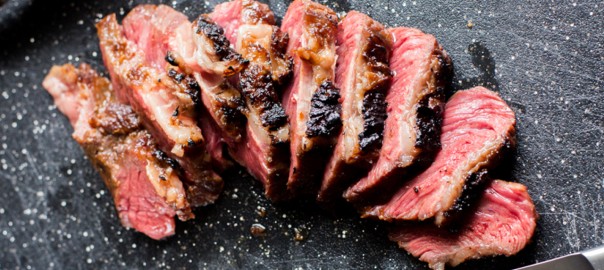You can find it featured on the menu of most reputable steakhouses, and although it goes by various names, when one thinks of a perfectly sized, tender, and flavorful cut of beef, likely, they are imagining a New York strip steak.
The strip steak comes from the topmost section of the sirloin, a little-used area of muscle, the longissimus, that is commonly referred to as the strip loin or top loin. The strip steak is sometimes prepared with a bone attached; quite often, you can find the strip is part of a T-bone steak or Porterhouse steak when part of a larger bone-in cut that also includes tenderloin steak — by itself, filet mignon.
Delmonico steak, Kansas City strip steak, or NY strip steak?
As a standalone steak, it is most commonly referred to as the New York strip steak, but it can also be called the New York sirloin steak, the Kansas City steak (with bone-in) or Kansas City strip steak, contré filet, strip loin steak, hotel steak, ambassador steak, club sirloin steak, or in some parts of the world, simply sirloin steak. Also, the New York strip can be — or has been known — as the Delmonico steak.
The connection to Delmonico’s, the famous New York steakhouse and restaurant first opened in Lower Manhatten in the 1820’s, is likely how the cut earned its most famous moniker, the New York strip steak. However, it is unclear if a Delmonico steak, or the original Delmonico steak, is, or ever was a strip steak from the top loin or a ribeye steak. The reason for the confusion is likely due to steakhouses across the country seeking to mimic Delmonico’s famous steaks, but using an array of different — yet similarly tender and thick — cuts. Those who have investigated the Delmonico and New York strip steak connection, refer to the cut also being called a club steak, a reference to the restaurant’s early days as one of the first American dining clubs.
However convoluted the naming history of the cut may be, one thing isn’t up for debate: New York strip steaks take relatively little preparation and can be cooked to a melt-in-your-mouth level of deliciously quite easily.
The perfect NY strip steak
Whether pan seared — or reverse seared — grilling on a charcoal or gas grill, or cooking by some other method, all a New York strip steak really needs is a coating of crushed black pepper and kosher salt or sea salt and some compound butter. Just a few ingredients, a few minutes of cooking time, and you can get the perfect steak for any steak lover. The easy prep is one of the reasons it pops up on restaurant menus so often.
According to ButcherBox Head Chef Yankel Polak, the lack of too much visible fat also makes New York strip steak a steakhouse favorite.
“There is a breed of steak lover out there who likes things a bit leaner,” Chef Yankel explains. “I used to see them in restaurants all the time; they would order a big ol’ ribeye and leave all that amazing fat sitting on the plate. It inspired me to offer a NY strip steak as the lean alternative.”
“When butchered properly, it has only a thin strip of fat running down one side — and besides its natural marbling — the strip steak presents itself as the less fatty menu option,” continues Chef Yankel.
And, there is a business reason as well: According to Chef Yankel, a NY strip steak is a high-value item for a restaurant because there is nearly no waste. “It dry ages well, cooks quickly, and requires almost no skill to do it perfectly and deliciously.”
“Personally I like slow smoking them at 225°F until they are rare, resting them for a bit, and then finishing them over a raging fire for the ultimate crust,” he added.
The cut does also benefit from a bit of marinating if you want to marry a grass-fed, grass-finished New York strip steak to other flavors you may be preparing. Below are two of Chef Yankel’s favorite methods for marinating and cooking the perfect New York strip steak.
NY Strip Steak with Chef Yankel’s Zesty Marinade Recipe
Ingredients:
- 2 ButcherBox NY Strip Steaks
- 3 limes, zest and juice
- 1 bunch fresh cilantro chopped
- 1 head of garlic, peeled and minced
- 1 Tbsp crushed black pepper
- ¼ c olive oil
Directions:
1. Combine all ingredients for marinade in small bowl. Mix well and coat steaks thoroughly.
2. Allow steaks to marinate refrigerated at least one hour, then bring steaks to room temp before cooking.
3. Grill steaks over charcoal or open flame for 4 to 6 min per side, or until internal temperature reads 120°F. Rest steak 8 min before serving.
Chef Yankel’s 5-minute NY Strip Steak Marinade Recipe
Ingredients:
- 2 ButcherBox NY Strip Steaks
Marinade/Dressing:
- ¼ c balsamic vinegar (the higher-quality, the better!)
- ½ c extra virgin olive oil
- 2 Tbsp Italian seasoning
- ½ tsp chili flakes
- 1 Tbsp garlic, minced
- 1 tsp lemon zest
- 1 tsp kosher salt
- 1 tsp black pepper
Directions
1. Preheat oven to 400°F.
2. Bring steaks to room temperature and season with salt and pepper.
3. Mix all marinade ingredients. Pour ¼ c over steaks and let them sit at room temp for 5 min.
4. Preheat cast-iron skillet. Once skillet is hot, sear steaks on both sides for 2-3 min per side or until a nice crust forms.
5. Place pan in oven for 5 more min, or until thermometer inserted in thickest part of steak reads 120°F.
6. Let steaks rest for at least 8 min before slicing. Serve alongside salad and enjoy!






